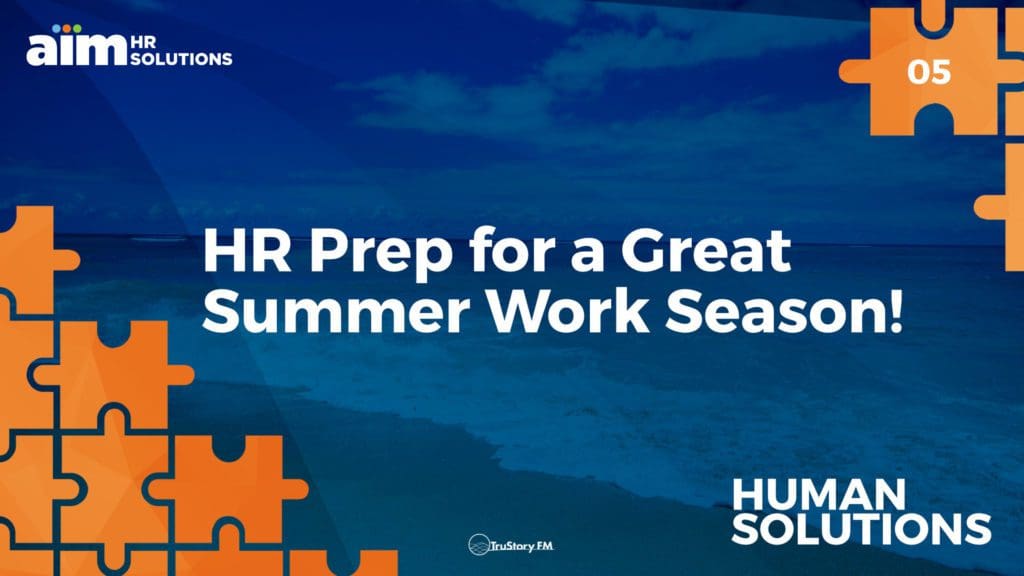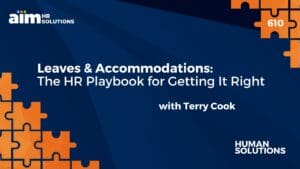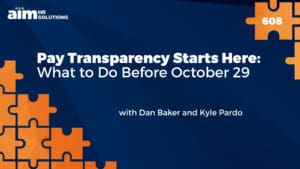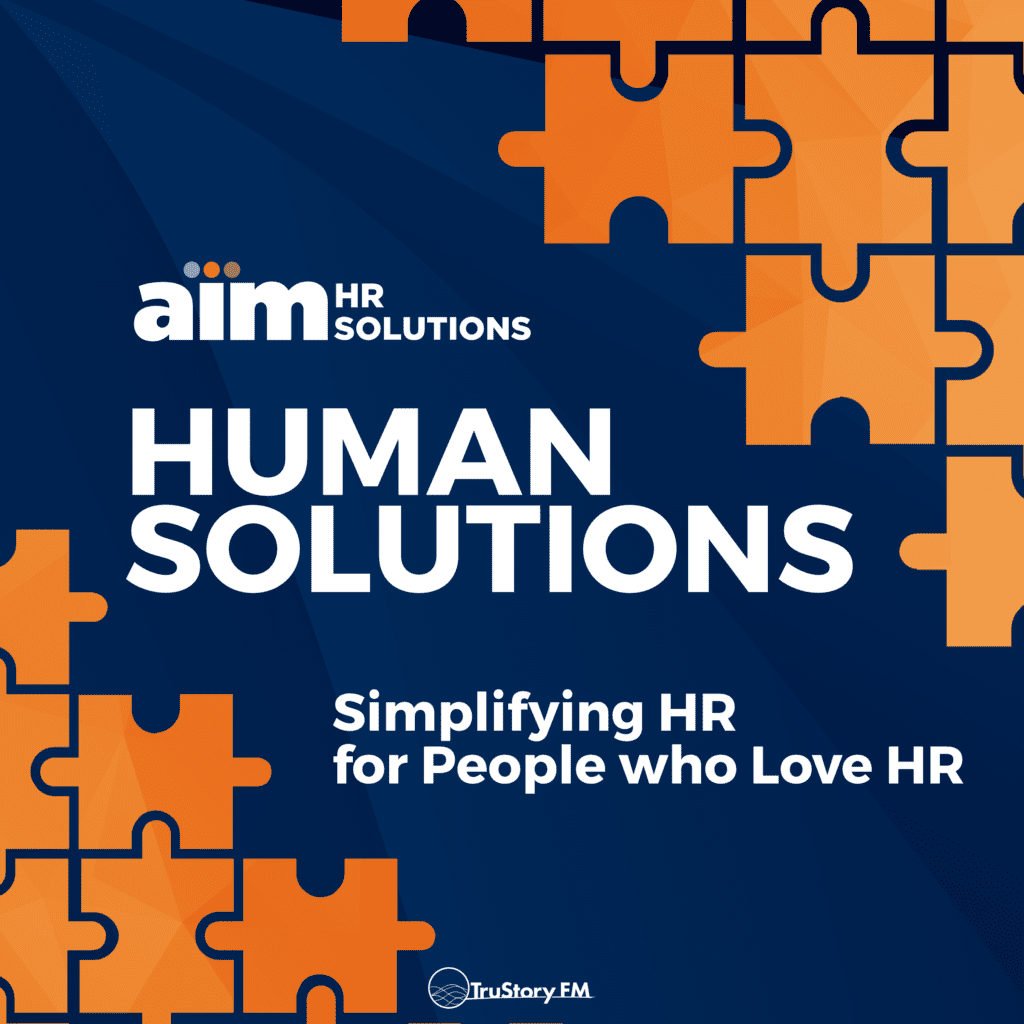We’re gearing up for the summer months and with the change in seasons comes a change in staffing for many of our organizations. Seasonal workers bring changing processes and may invite a younger demographic into your world. What do you need to know about hiring young people? Will you be impacted by child labor or Massachusetts Blue Laws? How will you navigate conversations around productivity and dress codes? Finally, are you ready to meet OHSA’s new heat standards?
Today, Terry Cook, Senior Vice President of Employer Services, and Tom Jones, our very own attorney specializing in labor and employment matters, join Pete Wright to talk about what workplaces face in the summer months and the compliance concerns you need to keep in mind before you hit the beach.
Episode Transcript
Pete Wright: Welcome to Human Solutions, simplifying HR for people who love HR from AIM HR solutions on TruStory FM. I’m Pete Wright, and this week we’re kicking off our shoes and heading into the surf. It’s almost summer. And with our return to beach time and barbecues, there’s plenty of HR and workplace stuff to keep you busy. Today, Terry Cook, our senior vice president of employer services, and Tom Jones, our very own attorney specializing in labor and employment matters, join me to talk about what workplaces face in the summer months and the compliance concerns you need to keep in mind before you hit the beach. Tom and Terry, welcome. We are talking about summer and what employers need to keep in mind as they go into the summer months. Before we get started, I know we have a definition of terms that we need to get out of the way. Tom, can you talk to us about what employers need to consider when it comes to Massachusetts Blue Laws?
Tom Jones: Absolutely. Thank you, Pete. And nice to be back. So Massachusetts has three, well, actually four now, summer Blue Laws that may involve the operation of a business. The first one is Memorial day, which everyone thinks of as traditionally the start of the summer. That’s usually the last Monday in May. And it is I think, 30th of this upcoming year. The newest holidays Juneteenth, which was passed two years ago, it’s June 19th. That’s not as big a summer holiday, but does have some of the impacts on especially retail operations. The third one is July 4th, which is Independence Day, which of course is one of the few holidays that moves throughout the course of the year. And I actually don’t know when it is this year, but it’s something to be mindful of. The final one is the close of the summer, if you think about it, is Labor Day. So each one of these major summer holidays, used to be that they would impact retail businesses significantly. But number of years ago, the law was changed so that most retail operations can operate throughout those four summer holidays.
Pete Wright: July 4th, this year is on a Monday, so long weekend.
Tom Jones: It’s on a Monday, the 4th of July"
Pete Wright: Yeah.
Tom Jones: Okay. So it’ll be a three day weekend for many people as a result of that. The other thing that does show up is that the pay, there’s a thing called premium pay in Massachusetts, which requires employers that operate in the retail sector on those summer holidays, all four of them, Memorial Day, Juneteenth, 4th of July and Labor Day to pay a premium. It’s currently 1.1 times the employee’s wage and they would have to pay that in order to get people to work on those days. That’s one side of the issue. Then there’s the manufacturing side, which is what do they need to do? In most manufacturers, it’s very difficult to open on the big three summer holidays, on Memorial Day, Labor Day and 4th of July. Generally, you have to get permission to do so, or you have to get people to participate. And typically what they do is they’ll pay by doubling someone’s pay or pay premium pay like time and a half to get people to come to work. But you can’t compel people to work on those holidays.
Pete Wright: Okay. All right. So those are all things to keep in mind. That’s what we’re referring to when we talk about the Blue Laws, where does it come from, Blue laws? Do you know where the name comes from?
Tom Jones: I honestly don’t. I assume it’s something to do with the origins of the church and its influence in the process. Perhaps the morality aspect of it, don’t know.
Pete Wright: The color of morality is blue. Outstanding. Okay. Then let’s talk about another major impact on seasonal work and that is hiring young people. Before we get started, round Robin, what was your first summer job as a teen? Terry?
Terry Cook: Bagging groceries at a grocery store.
Pete Wright: Bagging groceries, outstanding. Tom, first job?
Tom Jones: A summer camp counselor at a YMCA.
Pete Wright: Summer camp counselor. I was a conductor on the Manitou and Pikes Peak Cog Railway Train. You could probably guess I would do something with a microphone in front of my face. And I was one of those seasonal employees, right? And so I was the guy that they handed the horrible blue polyester shirt and said, “Go wear this and tell people where all the marmots and varmints are on this mountain.” And we only worked for a set number of months and there were considerations, I assume, that my employer had to take in order to employ me. But I was the dope on the train. I don’t know what those things are. Tell us what do employers and managers need to keep in mind when working with young or in particular, maybe first time staff? Terry, you want to kick us off?
Terry Cook: Sure. So I guess to start off in Massachusetts, there is a work permit requirement for anybody that’s working for you that’s under the age of 18. Typically, people can get those work permits either from the schools or they can get them from a town hall. So they have to have this work permit to present to the employer. The employer has to keep that in file because the person’s under the age of 18. So that’s probably the first thing in Massachusetts that comes to mind for employers for child labor laws. After that, there are several different rules depending on people’s age. So as you said, Pete, it depends how old you are and what rules are restricted to you. So there’s certain rules for 14 and 15 year olds, as far as how often they work, how many hours, what hours of the day they can work. Then there’s different categories for 16 and 17. And then there’s a category for people under 18 overall. One of the most interesting pieces that I’ve heard for questions over the years on people under 18 is what they can and can’t do at the workplace. Manufacturing, it’s very hard to put somebody under the age of 18 in your manufacturing floor. They can’t be around a lot of machinery. They can’t really even be around a forklift. They can’t be a passenger on a forklift. I can tell you-
Pete Wright: Until they’re 18?
Terry Cook: Under 18.
Pete Wright: Okay.
Terry Cook: And one interesting thing that I had happen early in my HR career, somebody hired their child that was under 18 to come on site, help us mow the lawn and paint. We were quickly told lawnmowers are machinery. If you’re under 18, you can’t have that person operate a lawnmower at your work place.
Pete Wright: Wow.
Terry Cook: So it was an interesting fact for me to learn early on in human resources because it didn’t connect. The person said, “I always mow my parents lawn.”
Pete Wright: Isn’t that the stereotype? Yeah.
Terry Cook: It is.
Pete Wright: Somebody can just walk around the neighborhood with your lawnmower and just offer to mow lawns for money. I don’t know. Am I dating myself by saying that kind of stuff?
Terry Cook: No.
Pete Wright: [crosstalk 00:07:03].
Tom Jones: … employment relationship though?
Pete Wright: That’s right. Okay.
Terry Cook: Yeah. Yeah. But I mean, honestly, that’s something people would think to do.
Pete Wright: Yeah.
Terry Cook: Something that they see people do every other place, to your point, Pete.
Pete Wright: Yeah.
Terry Cook: There are people, as Tom said, not in employment relationships that are mowing lawns in their neighborhood. But when you come to a company, that’s considered machinery.
Pete Wright: Okay. All right. Let’s turn then to the overall atmosphere of work. You go to work during the other nine months of the year, you were nice and productive and you hit the summer and is there such a thing as the stereotypical summer slump? Does productivity really slow down and what do you need to be thinking about as an HR professional?
Tom Jones: It may. I mean, I guess it would depend on the industry and how they … Because one of the things when you bring a bunch of people in for the summer is you have to be able to coordinate their efforts in the workplace and to integrate them into the workplace. So you have to have some staff in the management role actually coordinating what they’re going to be doing, how they’re going to be doing that, how they’re going to be trained if they need to be trained a little bit on what the responsibilities are they going to have? If it’s a cash register, if it’s some other thing, do they need to know how to do that? So there may be some disruption to the operation of the business, at least in the beginning, especially when you’re finally trying to incorporate them into the day to day operation. I mean, anecdotally, you’ll probably hear challenges employers have from getting people to understand the discipline of work, as opposed to the day to day life of school, if that’s where they are outside of that. So there’s going to be a structure that will be different, expectations that will be different perhaps on a more day to day basis when they have to deliver certain things, be it counting the till at the end of the day or putting clothes away on a rack or whatever that might be. They’re going to have to be responsible at a different standard, I think, than they might have been. So there may be easily some disruption to a business for actually hiring someone.
Pete Wright: It’s an interesting sort of, let’s see, conflict perhaps where not only you’re bringing in summer staff and you have to teach them what to do, you also in many cases now have to take the responsibility of teaching them how to work, how to be an employee. Terry, what considerations you have in taking on that role of work educator?
Terry Cook: Sure. Yeah. Work education is a big piece. If you can’t tell somebody what you’re expecting, you can’t expect them to do it. So again, just really as Tom mentioned, fully explaining the job, what are the expectations? How are we measuring the productivity during a day or a week? It’s important for some people to have that direction and understanding what needs to be done. Maybe assigning initially a mentor or somebody on staff to really work with that person, really get them up and running in their position so that they feel comfortable doing what they’re doing. It’s hard to find help nowadays. So when you do, it’s important to educate and do everything you can to keep them. The only other point I would add to what Tom said is if you can, depending on the setting, what some employers will do is arrange the schedules such that they might get out early on Fridays in the summertime so that they get a jump start to their holiday weekends, their summer weekends, their time away. So it’s something for them to look forward to and also to make sure they’re productive throughout the rest of the week so that they can get out at a half day on a Friday.
Pete Wright: Okay. No conversation about summer would be complete without a segment on summer fashion trends. As we head into summer ’22, what are the big trends we’re bringing back to work? And how do you recommend handling the workplace dress code in a way that is politically correct? Tom, it’s time we peek into your closet. What do you think about handling the workplace dress code?
Tom Jones: First, what we’ve been talking about and people come in with very different expectations. One need only walk through a high school to see a different standard of dress than you might see in a regular workplace. And people perhaps revealing a little bit too much or sloppy clothing. A company’s very concerned about their image. And so one approach could be to give people the equivalent of something like a polo shirt or a shirt with the company logo that says, in order to work here you must wear this top during the course of the workday, which eliminates some problems. We see a lot of companies want polo shirts on their employees or just the t-shirt that says, XYZ company. And that’s one way to at least address the upper half of the body. Look at their existing dress code policy. What does it say? And try and convey that message to employees at the time of hire, they say, “Okay, here’s what we expect you to do. We’re a professional setting. We expect these things to be a part of what we do. So here’s what they are. And we expect you to dress this way.” So you can convey that message, to Terry’s point, a mentor might be the one to do that on a regular basis. So, that’s one side of it. I’ll let Terry take the other half.
Pete Wright: Well, and that’s what I was going to say. Maybe we need to pivot to what we’re trying to protect in terms of the organization and our relationship with these new employees by having this conversation the right way. Terry, what are we really trying to do?
Terry Cook: Well, and it depends on the work setting too, Pete. I mean, like Tom mentioned a dress code policy. Does the company have a dress code policy? That might be the start, because some companies do and some companies don’t. But there are other ways to look at it. So you mentioned, or Tom also mentioned, a little bit of the revealing clothing that can also be handled through a policy such as harassment policy, educating them to know what could be at risk in that sense. In my experience being in a manufacturing environment, safety could be a piece to this that people have to explore. Are people wearing loose clothes that could get caught in machinery? Is there too much skin exposed to the point where if they’re around hot equipment, they could get burned? So there’s a safety aspect, there’s the policy aspect, the harassment aspect. I think to your point, Pete, it’s all about educating, making sure people understand your expectations in order to hold them accountable to them.
Pete Wright: It gets me thinking just about reviewing whether or not you have a clothing or a dress code policy. That’s the time also to address religious or cultural clothing, right? Are there health and safety concerns around individuals because of their faith who are wearing some sort of headrest that they need to consider? And at what point do you consider those elements in the dress code, not just summer?
Tom Jones: I think that’s right. And I think also an important part of that is, so let’s say you have a low level manager who’s sort of bringing on the staff for the summer and someone poses the issue of a religious concern. That person shouldn’t try and answer that themselves, they should be reaching out to HR. They should be reaching out higher up in the organization so that there may be past practice that they want to be able to look back at and say, “Okay, this is what we’ve done previously.” And just make sure nobody puts their foot in it and inadvertently says no to something or yes to something. I mean, there’s a case that years ago from Oklahoma, where the young woman who wanted to work at Abercrombie, 17 years old, high school kid had a hijab. She had a little headdress on. The hiring people locally said, “Well, we’ve hired Jewish kids with yamakas, so this shouldn’t be an issue.” Says, “Okay.” Higher up in the corporate ladder it turns out they said, “Oh no, no. It’s a bad thing. You can’t do it.” And so they didn’t give her the job. She sued when all the way to Supreme court. And she won showing that she qualified for the job, the headdress does not impact her ability to perform the job and so the company should not have, unless there’s some safety issue that they were unaware of and there wasn’t, they had no basis for not giving her a job. So you want to make sure your consistent in your policies. You don’t accidentally create a discriminatory environment situation where there isn’t one, where there shouldn’t be one.
Pete Wright: We’ve talked about health and safety in terms of dress code policy. Are there other organizational health and safety concerns or issues that you want to be able to sort of peek around that summer corner that we haven’t discussed yet?
Terry Cook: Yeah, actually we just saw something come out from OSHA about heat in the workplace. And they’re starting a program where they’re proactively inspecting many companies, not restricted to the people’s typical companies that they think will be inspected in this type of heat environment. But the heat index they’re looking at is just 80 degrees. And essentially what they’re saying in this act is they can proactively look out into different companies once they see the heat index reach to see how companies are handling it, how companies are helping their employees, because there are so many injuries every single year with heat related issues.
Pete Wright: And changing year, over year, over year. Right, Tom?
Tom Jones: This is a whole new initiative from OSHA and it’s yet to be clear how it will play out. But you know at some point come 4th of July weekend or some place when it’s burning hot, some company’s going to get cited and they’ll say, “Oh, I didn’t expect this.” And it’ll be a surprise for them, but a good education for everyone else as to what the criteria are they’re looking for. Because it’s really about, if you look at the evidence, heat really does potentially decimate a workforce depending on the work situations.
Terry Cook: Right. And I think what happened in the past, is what I understand, is that OSHA would wait until there was a heat related injury to really go out and inspect the heat issues. So by putting this new program in place, they’re taking a more proactive approach to try to prevent those injuries from occurring rather than reactive to an inspection after the injury.
Pete Wright: For all of these issues, we’re looking at, what steps can you take this summer to keep your teams healthy, safe, happy, and fashionable all summer long? Thank you, Tom and Terry for joining me for this conversation and for teaching our fantastic audience about these issues they need to keep in mind. And thank you everybody for downloading and listening to this show. As always, you can find links and notes about the show at aimhrsolutions.com. You can listen to the show right there on the website or subscribe to the show in Apple Podcasts, Spotify, and anywhere else you find podcasts are served. Until next week, thank you.











